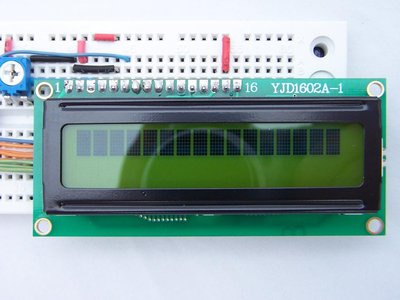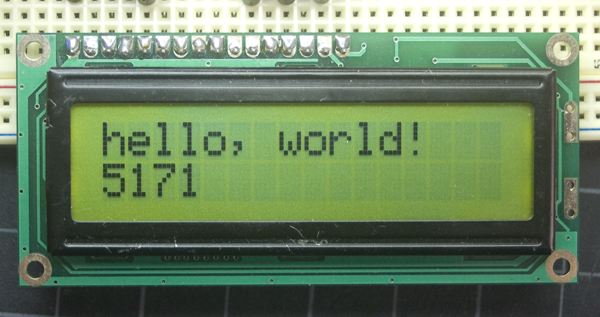Nearly every pixel-based alphanumeric LCD module made today uses the Hitachi HD44780 LCD controller chip, or a derivative such as the Seiko-Epson SED1278. This apparent standardization in. Once you’ve programmed and tested the beating heart of your Arduino clock, you need a way to display the time without using the serial monitor. This is where the LCD display comes in. This one is fairly inexpensive and it uses the very common Hitachi HD44780 driver. These LCD modules are easily. I am using the Arduino Due with the 16x2 LCD display and was wondering if somebody have written a library for the LCD compatible with Hitachi HD44780 driver. I am using Atmel Studio to program the Arduino Due not the Arduino IDE. LCD character displays can be found in espresso machines, laser printers, children’s toys and maybe even the odd toaster. The Hitachi HD44780 controller has become an industry standard for these types of displays.
Once you’ve programmed and tested the beating heart of your Arduino clock, you need a way to display the time without using the serial monitor. This is where the LCD display comes in.
This one is fairly inexpensive and it uses the very common Hitachi HD44780 driver. These LCD modules are easily recognized because they have 16 pins in a single row and use what’s known as a parallel interface.
Because of this, the Arduino uses several digital pins to make the display work. This process is somewhat complicated, but luckily, there is an Arduino library for it already that makes it very easy to send text to the screen without worrying about the low-level commands that would otherwise be needed.
You use 4-bit mode to display text, which needs only seven Arduino digital pins to control the display. You also need power for the LCD itself, and for the backlight. Finally, you control the contrast of the display by using the potentiometer.
Connect the following:
Add your LCD display and potentiometer to your breadboard.
Connect the power and ground pins on your LCD, which are Pins 15 and 16, respectively.
Connect the ground and power for your LCD’s backlight, which are Pins 1 and 2, respectively.
Connect the control pins for your LCD to the digital pins on your Arduino.
16×2 LCD Display Pin Arduino Digital Pin 1 (to GND rail on breadboard) 2 (to +5V rail on breadboard) 3 2 4 3 5 4 6 5 7 (no connection) 8 (no connection) 9 (no connection) 10 (no connection) 11 11 12 (to GND rail on breadboard) 13 12 14 (to potentiometer middle pin) 15 (to +5V rail on breadboard) 16 (to GND rail on breadboard) Now connect the potentiometer, which controls the display’s contrast.
The center pin of the potentiometer should go to Pin 14 of the LCD display and the other two pins of the potentiometer are connected to power and ground, in any order.
Now that you have connected your LCD, it’s time to make it do something interesting! First you need to upload some code to make sure that the LCD is working properly. This code is the first part of your alarm clock sketch. You build upon it to add all the other functions for your clock.
You can copy the code for the clock all at once, but consider adding it in sections, as described here. That makes it easy to troubleshoot problems and test the clock in stages, as you build it.
Enter the following code into the IDE, or download it from the companion website and upload it to your Arduino:
When this code is uploaded, you should see the message “It’s Alive!” displayed for a half-second on the LCD. If you don’t see anything, or if the display has garbled characters, you’ve connected something incorrectly. Go back to the wiring table.
The first three lines of this code include the libraries that are be used for your clock. The first includes the I2C library that enables communication with the RTC module. I2C, pronounced “eye-squared cee” or “eye-two-cee,” is a communication link for talking between integrated circuits,in this case your Arduino and the Dallas DS1307 chip.
It’s also useful for communicating with lots of other accessories, such as GPS modules. The useful thing about I2C is that it only requires two pins, plus power and ground. This library makes communication pretty easy with most I2C devices.
The next library is the RTCLib. It’s a version of a library written by JeeLab and modified by Adafruit Industries for communicating with the RTC module. It’s used for getting the time from the RTC module and uses the I2C library to negotiate that communication.
The last library is the LCD display library, which handles the parallel communication with your display. Unlike the RTC library that you added manually, it’s included as a standard library in the Arduino software distribution.

After including the libraries, the code creates two objects: a clock object called rtc and a LiquidCrystal object called lcd. This object has parameters that determine which digital pins the Arduino uses to communicate with the LCD.
After creating those objects, the setup() function gets things going. The I2C, RTCLib, and the lcd, all have to be enabled, which is done by the begin() function. The lcd.begin() function takes two parameters, the number of columns and the number of rows, which on your display are 16 and 2. After this has been set, you can write messages to the screen simply by using the lcd.print() function:
There are two spaces at the beginning of this text, which centers the 11-character message within the 16-character space on the top line. You normally control the position of text with the setCursor() function, but it’s not needed here — one less instruction to put into setup().
After a brief delay so that you can see that it has been printed to the screen, the lcd.clear() function wipes all of the text, ready to go for the main loop().
Hello all,
I have started working with Texas Instruments MSP430 value line micro controllers. I still enjoy working with Ardunio but I can pick up a 16 bit TI MSP-EXp430G2 for $9.95.
Texas Instruments is a large company and has really embraced the DIY, maker community. Their online support and documentation is fabulous.
I started getting familiar with the chip architecture for the above MSP430. What better way to learn about the chip then to write some code.

I have a few LCD display lying around and decided that this would be a good project to develop.
In doing some digging out on the web I discovered that many LCD displays use the Hitachi HD44780 controller as a programmable interface.
I did some searching out on the web and found a few code examples and one library that implements code for the HD44780.
But most of the code was only small samples of code and really was not formatted for for real production use.
Most of the code I found was incomplete, and really buggy, When I pressed the reset button several times the display when nuts and displayed corrupted characters.
I did find one example of someone who put together a rather nice library, well documented but was missing some common functions that I wanted.
Also nowhere did I fine any really good code samples that implemented the features of the HD44780 interface.
So I decided to take the following library and modify it to add the features that I wanted and then provide some working code examples.

So a bit thanks goes to nikosapi at
Below I will publish some links to my Kiln repository, with public access so everyone can download the code.
Over the next few posts I will also discuss the coding samples I put together.
I have put together a YouTube video of the code samples printing out to a 2 line 40 character display that prints 4 lines, 20 characters each. If you have a different LCD display the library functions will still work, you may have to alter the text length that you are sending in the example code.
Here is the link to the Kiln repository, Click on the 'Download Archive' to download the files to your workstation:
The library was tested using the above MSP430 launchpad, but the library should work with most micro-controllers.
The library and code samples were created in Texas Instruments Code Composer Studio, which is an Eclipse application with custom plug ins.
Lcd Hitachi Hd44780 Driver For Mac
But the code can be taken with run with any tool chain.
Hitachi Hd44780 Driver
Download the code so you can follow along: